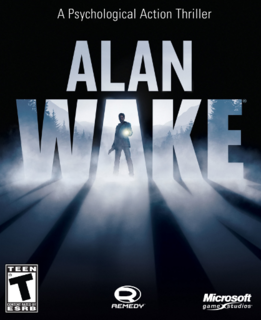Alan Wake, isn't initially an action hero. He's a popular fiction writer attempting to escape the pressures of fame and creative expectation whose vacation in Bright Falls quickly turns Twin Peaks weird. His wife goes missing, and his search to find her is swiftly diverted into the realm of the paranormal, forcing him to pick up a gun and pull the trigger to stay alive. It's an adventure heavily informed by television shows like X-Files and Twilight Zone and horror fiction from Stephen King and H.P. Lovecraft. Presentation, character building, and plot twists take on just as big a role as the tightly wound action gameplay you'd expect from a Remedy title. The result is a swirling tale of fiction that's endearingly self-aware, that occasionally sputters and stumbles, but offers enough scares, laughs, and thrills to keep you hooked. The core story spans six episodes, each crafted like part of a TV miniseries. After the first episode's exposition each that follows ends with a cliffhanger, fades to a title screen (strangely without credits) as songs from the game's excellent licensed soundtrack play, and then transitions into a plot recap as the next begins. Even if episodic gaming isn't particularly original at this point, the style of the presentation fits with what Remedy is trying to accomplish here; delivering a video game experience that feels like a novel presented as a TV show. This blending of different arts touches all aspects of the game, from how the story is told within each episode, the way the characters are developed, to how you interact with the environments. In place are standard cut-scenes where characters interact and advance the action along with plenty of inner monologue voice over from Wake as he comes across new and strange phenomena. Like in a written work, this allows for insight into the mind of the protagonist without the need for overly artificial character interaction to draw it out, and various other storytelling devices further fragment the order of reality. Techniques employed by Remedy to convey the unfocused rage of Max Payne, a game fans will find references to throughout Alan Wake, are used more subtly here to generate a sense of mystery, isolation, and creeping dread. By leaving the straightforward path to the next checkpoint and exploring the surroundings, radios and television sets can be found in spots like wooden lookout towers and construction site trailers. It may be tempting for some to plow past these extras to get to the end, but I'd strongly advise you take the time to listen to and watch everything you can. It highlights what a great job Remedy has done building a richly detailed game world that retains authenticity even as its plot spirals further into the mists of the fantastic. Details delivered through radio broadcasts and the Twilight Zone-esque live-action "Night Springs" television show poke fun at the genre's conventions, build out character, and dump more self-referential slabs into Remedy's melting pot of mediums. Wake frequently stumbles across manuscript pages, serve the purpose of providing perspective from other characters not otherwise possible, foreshadowing events to come, as well as explaining bits of the back story. The twist is the pages were written by Wake himself, something he can't recall doing. Making sure you explore and collect as many as possible helps to more fully develop the world and story, as well as building tension as the game blurs truth and fiction. Bright Falls and its forested mountainous surroundings are masterfully realized and resonate with realism. Wake is a famous figure everyone recognizes, all the townsfolk know each other, and they seems more concerned and excited over an upcoming town festival than they are with the dangers encroaching from all sides. Of course everyone has their secrets, some malevolent and some hilarious, and sifting through the radio programs, manuscript pages, and talking to everyone helps solidify their identities. While many still come off as stereotypical, there's the staple comic-relief character, the batty old woman, the good-hearted local cop, the troublesome FBI agent, the way they behave and interrelate keeps them entertaining. Remedy built in a large amount of extraneous dialogue that's worth hearing so if you find a character be sure to hang around and listen to what they've got to say, even if not all the voice acting is of the same high quality. Additional character is exuded by the design of the environments. Remedy's skill with crafting spaces that feel lived in is readily apparent. Locations are packed with detail and feel rusted and worn. Weeds choke the back lot of the police station, surrounding the husk of a long forgotten vehicle. A recliner ringed with beer cans sits atop a construction container overlooking a brilliantly lighted power plant, reinforcing the idea that there isn't a whole lot to do for fun around these parts. A mental therapy building is lined with inspirational posters and idyllic paintings that reflect the ego of the proprietor and function of the establishment. This intimate scale of detail is then juxtaposed with sprawling vistas as you peer deep into moonlit mountain valleys rippling with shadow. It gives the game a sense of place and purpose, making it an easy world to identify with.
Load Comments (0)

